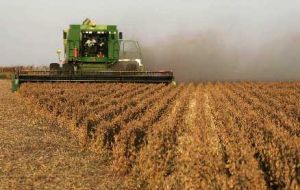MercoPress. South Atlantic News Agency
La Niña threatens Brazil and Argentina crops says Oil World
 Soybean production in South America reached 136.4 million tons in early 2011
Soybean production in South America reached 136.4 million tons in early 2011 South American grain and oilseed production may be in jeopardy from the formation of a La Niña weather pattern, which might curb rainfall in parts of Brazil and Argentina, Oil World said.
Dry weather since April in central Brazil may prevent seedlings from taking root when sowing starts in Mato Grosso, Mato Grosso do Sul and Goias states, the Hamburg-based researcher said in a report today. The weather pattern may bring rain to the area in December, too late for crops, it said.
“At the moment, sea-surface temperatures are near normal across the equatorial Pacific Ocean, but there are indications that anomalies are developing, creating La Niña conditions and probably reducing rainfall in some important oilseed- and grain- growing areas of South America,” Oil World said.
Argentina’s wheat crop is the biggest in Latin America. The country is the world’s second-largest corn exporter and Brazil ranks second globally among soybean shippers, both after the US. Corn has gained 14% this year in Chicago trading, the second-best performance among grains after rice, and soybeans have fallen 4.3%.
Rising Chinese demand for soybeans and corn has bolstered the crops’ prices. The US Department of Agriculture last week lowered its estimates for world corn stockpiles and soybean inventories. That put more pressure on Brazil and Argentina to compensate for lost US production, Oil World said. China is the world’s top soybean importer.
“South America has grown in importance as an exporter of soybeans, soy oil and meal, satisfying a growing share of world import requirements because US export supplies have been insufficient” the researcher said.
Soybean production in five South American countries that reached a record 136.4 million metric tons in early 2011 may fall more than expected next year because of adverse weather and competition from corn and wheat, according to the report.
Brazilian soybean stockpiles at the end of August will come to 26 million tons, up 39% from the prior year, Oil World said. In the next marketing year, dry weather and a smaller planted area as growers seed more grains will hurt oilseed inventories in the country, according to the report.
“Although larger-than-expected soybean stocks will be available worldwide at the end of August 2011, the prospects for a decline in world soybean production in 2011-2012 will tighten supplies, raising prices of soybeans, oil and meal well above the levels expected up to now,” Oil World said.




Top Comments
Disclaimer & comment rules-

Read all comments“La Niña threatens Brazil and Argentina crops says Oil World” hahaha this is the most laughable title I've ever read hahaha scary!!! do you have any idea how many NIÑAS have passed over these lands of ours? hahaha you won't be left without food, don't worry.
Aug 18th, 2011 - 12:11 am 0I'm eating pochoclo, do you want some? qué ricoooooo!!!
Commenting for this story is now closed.
If you have a Facebook account, become a fan and comment on our Facebook Page!